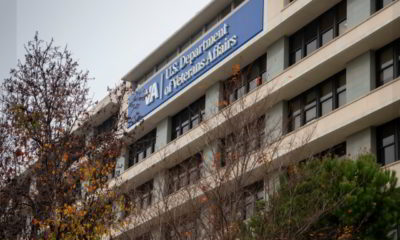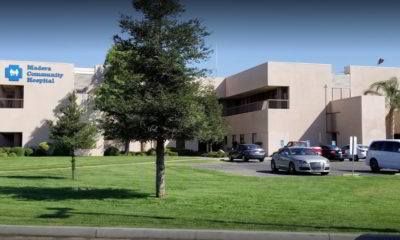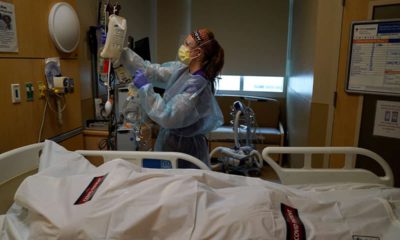News
Virtual Academy Will Train ‘Disease Detectives’ by Tens of Thousands in CA
Published
5 years agoon
One of the keys to reopening our economy — and keeping it open — will rest in the hands of “disease detectives.”
In the medical community, they’re called contact tracers. The name describes exactly how they’ll crack the cases.
It’s estimated that Fresno County alone will need 300 of them. Currently, the county has a fraction of that number.
Testing kits, swabs, ventilators, and reagents have defined the effort to corral the coronavirus pandemic for weeks. Contact tracers are the next big tool.
[rlic_related_post_one]Virtual Academy
“UCSF and UCLA will be providing a virtual academy for a recruitment effort and training effort for new tracers,” Gov. Gavin Newsom said during a Monday news conference. “These simply disease detectives. Currently, every county in the state of California does some form of tracing.”
The governor’s office says the UCSF and UCLA partnership will immediately begin training workers for what his office describes as “a landmark contact tracing program.” The goal is to contain the virus while the state looks to modify the stay-at-home order.
The partnership will include a virtual training academy for contact tracers. The first 20-hour training is Wednesday as the state embarks on training 20,000 individuals in two months. The governor stated these will not be newly hired people, but at least initially, they will be repurposed municipal employees.
UCSF is already working with the city of San Francisco to develop one of the first large contact tracing teams in the state. The San Francisco mayor’s office says they’ve already trained librarians, public health and city attorney staff, plus UCSF medical students.
Contact tracing is different for each disease because the definition of contact depends on how the disease is transmitted, according to UCSF. The transmission risks for measles, which can waft across a room, and HIV, which usually requires sexual contact or needle sharing, are vastly different than for COVID-19.

Gov. Gavin Newsom outlined a “landmark tracing program” for COVID-19 during his Monday, May 4, 2020, news conference. (AP File)
Contact Tracing for COVID-19
UCSF’s Dr. Michael Reid says, “Disease case investigators are very skilled at asking probing questions.”
The list of contacts is entered into an online system called DIMAGI. From there, Reid’s contact tracers take over.
When a contact tracer logs into the system, the contacts and their phone numbers are shown. The contacts first receive a text message telling them the department of public health has important health information and will call them from a specific number.
“So we have actually found that a lot of people do pick up their phones,” said UCSF’s Susie Welty, who has been working four-hour shifts, five days a week for the past three weeks.
Once she reaches a contact, Welty goes through a script, first informing the contact that they were likely exposed to the coronavirus. She doesn’t reveal who they were exposed to, but sometimes it’s obvious, she said, like when it’s someone they live with. She tells them they are required to quarantine for 14 days.
Fresno County Contact Tracing
“You can pick up on trends pretty early. If you have really smart people in place to do contact tracing,” says Dr. Rais Vohra, Fresno County’s interim health officer.
Vohra says he now has 30 to 50 people dedicated to contact tracing. He says there’s a need for 300 based on the county’s population. That number will provide a good handle on backtracking the disease’s spread.
Vohra also says it’s important to have the tracers strategically placed throughout the county: “It’s going to be, frankly, unrealistic and unfeasible to have 300 extra people here in our building.”
Merced County Contact Tracing
Dr. Salvador Sandoval with Merced County Public Health told GV Wire that the department has 28 contact tracers. Sandoval says his team has been able to handle the caseload but will likely need more tracers if the county sees a spike in the virus. So far, Sandoval is not clear on how many people Merced County might get from the state training program.
The health department is also working with the Merced County Sheriff’s Office for help in the initial contact tracing steps.
Madera County Contact Tracing
The Madera County Health Department tells GV Wire by email it has 11 contact tracers on-site.

“If COVID is the criminal, then we want to find how many people that COVID has contacted or had near contact with.”—Madera County Sheriff Jay Varney
“As of right now, we have been able to contact trace successfully within approximately an hour from when a positive case is known,” said Dr. Simon Paul, public health officer for Madera County. “We find that the state training will be very beneficial and the digital platform that will help us trace contacts from neighboring counties is welcomed and much needed.”
Madera County Sheriff Jay Varney compared rapid contact tracing to a criminal investigation. In a Facebook video, Varney said, “If COVID is the criminal, then we want to find how many people that COVID has contacted or had near contact with.”
CDC: Contact Tracing Is a Key Strategy
The Centers for Disease Control recently updated its guidance to health professionals on contact tracing.
“Contact tracing, a core disease control measure employed by local and state health department personnel for decades, is a key strategy for preventing further spread of COVID-19,” states the CDC. “Immediate action is needed. Communities must scale up and train a large contact tracer workforce and work collaboratively across public and private agencies to stop the transmission of COVID-19.”
The CDC also warns about what will happen if contract tracing isn’t done properly.
“If communities are unable to effectively isolate patients and ensure contacts can separate themselves from others, rapid community spread of COVID-19 is likely to increase to the point that strict mitigation strategies will again be needed to contain the virus.”
You may like
-


Study: First 10 Days After Leaving Hospital Pose Deadly Risks for COVID Patients
-


Bay Area Restaurants, Wineries File Lawsuit Over Outdoor Dining Ban
-


Madera Hospital, With ICU Inundated, Transfers Patients to Other Facilities
-


‘Shameful’: US Virus Deaths Top 400k as Trump Leaves Office
-


Bill McEwen: Five Steps to Heal America Under Biden
-


Trustee Slatic Calls for ‘Redshirt’ Year for High Schoolers When In-Person Classes Resume














Marie
May 5, 2020 at 10:22 am
Will you leave us alone already and let us live our lives.
MGomez
May 5, 2020 at 3:55 pm
Newsflash to the CDC:
Your “strict mitigation strategies” have ruined our economy, and it will require decades to recover.
R
May 5, 2020 at 5:04 pm
Our rights disappear, and the police state grows. Never let an opportunity go to waste.
Alan Steinberg
May 8, 2020 at 11:19 am
How can I sign up to be a contact tracer? I work at UCLA.